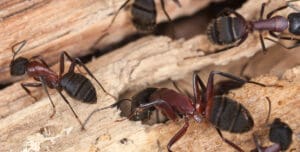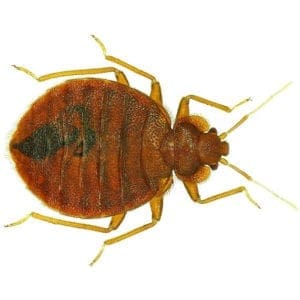

Silverfish are common household pests that can quickly become an unwelcome presence in your home, scurrying about unnoticed. In this article, we’ll guide you through identifying and preventing silverfish infestations, along with effective methods for how to remove silverfish and protect your home from future invasions.
What Are Silverfish
Silverfish are small, wingless insects measuring ½ to ¾ inches in length. They have slender, teardrop-shaped bodies covered in silvery-gray scales, giving them a metallic sheen. Their movements are quick and fluid, resembling a fish swimming, hence their name. Silverfish have long antennae and three bristle-like appendages protruding from their rear.
Behaviorally, they are nocturnal and typically inhabit environments such as bathrooms, basements, and kitchens. They feed on starchy materials, including paper, glue, and fabrics, making them common household pests. Despite their nuisance, silverfish are harmless to humans as they do not bite or spread disease.
What Causes Silverfish in a House?
Silverfish are attracted to homes that provide the ideal conditions for their survival: humidity, food sources, and dark, damp environments. They thrive in areas with high humidity, typically above 75%, which is why they are often found in bathrooms, basements, kitchens, and laundry rooms. Leaky pipes, poor ventilation, and areas with moisture buildup can make your home particularly appealing to these insects.
Food is another significant factor. Silverfish feed on a wide variety of starchy and sugary materials, including paper, glue, wallpaper paste, books, cardboard, and even certain fabrics like cotton and linen. Homes with clutter, old books, or stored paper items can be an unintended buffet for silverfish. They may also consume food crumbs, cereals, and pet food if accessible.
Additionally, silverfish prefer dark, undisturbed spaces where they can hide during the day. Cracks, crevices, and storage areas provide ideal hiding spots. Their preference for these environments often leads them to infest places like attics, closets, or areas behind furniture.
How to Get Rid of Silverfish
Here are some room-specific tips for removing silverfish from your home:
Silverfish in Bathrooms
To eliminate silverfish in bathrooms, start by addressing the humidity. Use a dehumidifier or ensure good ventilation by running an exhaust fan during and after showers. Fix any leaky faucets or pipes to remove sources of moisture.
Clean the bathroom thoroughly, paying attention to crevices where silverfish might hide. Remove clutter like old magazines, cardboard, or unused toiletries, as these can attract them. Seal cracks and gaps in walls, baseboards, and around fixtures to limit their hiding spots.
Silverfish in Closets
To remove silverfish from closets, start by decluttering and organizing. Silverfish are attracted to starchy and cellulose-rich items, so remove old papers, books, and cardboard boxes. Store clothing and items in sealed plastic bins or vacuum-sealed bags to deny silverfish access to potential food sources like fabric, especially cotton, linen, and silk.
Vacuum the closet thoroughly, especially corners, crevices, and along baseboards where silverfish may hide. Clean the area with a damp cloth and mild detergent to remove dust and debris. Consider using a dehumidifier or silica gel packets in the closet to reduce humidity. Ensure the space is well-ventilated and dry.
Seal any cracks or gaps in walls, flooring, or around the closet's edges to prevent silverfish from entering. Natural deterrents like cedar blocks, lavender sachets, or diatomaceous earth can help repel or eliminate them.
Silverfish in Kitchens
To eliminate silverfish in kitchens and food storage areas, start by decluttering and cleaning. Silverfish are drawn to starchy materials and crumbs, so thoroughly clean cabinets, drawers, and shelves, removing food debris, old paper liners, and any accessible food sources. Store dry foods such as cereals, flour, and pasta in airtight containers to prevent access.
Inspect the area for moisture sources, as silverfish thrive in damp environments. Fix leaky pipes, faucets, or drains, and ensure proper ventilation. Use a dehumidifier or place silica gel packets in cabinets to reduce humidity levels.
Seal cracks, gaps, or crevices in walls, floors, and cabinets to block entry points. Sticky traps or jar traps baited with starchy foods can catch silverfish in areas where they are active. Diatomaceous earth or boric acid can be applied in small amounts around the edges of cabinets and baseboards; these natural substances are toxic to silverfish but safe if used correctly. Regularly monitor and maintain cleanliness by vacuuming and wiping surfaces to remove dust and food particles.
Silverfish in Bedrooms and Beds
Silverfish are drawn to paper, books, and fabric, so remove any piles of magazines, cardboard boxes, or papers from the room. Store items in airtight plastic containers instead of cardboard or paper-based ones. Wash bedding, curtains, and other fabrics in hot water to eliminate any silverfish or their eggs.
Vacuum the bedroom, focusing on corners, under furniture, and around baseboards where silverfish may hide. Use a damp cloth to wipe surfaces, removing dust and food particles that might attract them. Address moisture issues by using a dehumidifier and ensuring proper ventilation to keep the room dry. Place silica gel packets or moisture-absorbing products in vulnerable areas like under the bed.
Silverfish in Attics
Getting rid of silverfish in attics requires addressing the environment, food sources, and entry points that attract them. Start by decluttering the attic, and be sure to properly store all papers, books, and fabric. Replace cardboard storage containers with airtight plastic bins to deprive silverfish of food and shelter. Remove any unused or decaying materials that could attract silverfish. Thoroughly clean the attic, vacuuming corners, cracks, and crevices where silverfish hide. Use a damp cloth to wipe down surfaces, removing dust, debris, and organic matter. Pay close attention to areas around insulation, where they may nest.
Reduce humidity in the attic, as silverfish thrive in damp conditions. Use a dehumidifier if necessary and ensure proper ventilation. Check for roof leaks or gaps that might contribute to moisture buildup and fix them promptly.
Seal cracks, crevices, and gaps in walls, flooring, or rooflines to block entry points. Spread diatomaceous earth or boric acid along baseboards and in corners as a natural deterrent. Sticky traps or bait stations can help capture silverfish in active areas. For persistent infestations, consult a silverfish pest control professional. Regularly monitoring the attic, maintaining low humidity, and keeping it clean will help prevent silverfish from returning.
How to Repel Silverfish and Prevent Future Infestations
To repel silverfish and prevent infestations, keep your home clean and free of clutter, especially in damp areas like basements, bathrooms, and kitchens. Store items like books, papers, and fabrics in airtight containers. Reduce humidity by using dehumidifiers and ensuring proper ventilation. Fix leaks and eliminate moisture sources, such as damp wood or wet clothes.
Seal cracks, crevices, and gaps in walls, flooring, and around pipes to block entry points. Use natural repellents like cedar, lavender, or diatomaceous earth in problem areas. Regularly vacuum and dust to remove potential food sources, and monitor for signs of re-infestation.
If you’re struggling with silverfish, taking immediate action is key to protecting your home or business. With our residential pest control and commercial pest control services, we can help eliminate these pests and prevent future infestations. For expert assistance, don’t hesitate to contact us today for a tailored solution.






